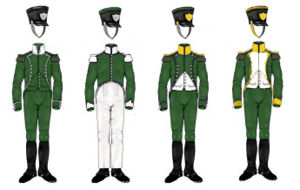Continental Marines
| This article is a proposal
|
The Continental Marines is the branch of the North American League military responsible for providing force protection from the sea. Originally organized as a Naval Infantry, the Marines evolved over time with the advance of technology and military doctrine. Administratively, it is part of the Department of the Navy, but functions as distinct branch--mostly as specialists in things like amphibious infantry operations.
In general, the Continental Marines share many resources with the other branches of the NAL military. However, they have consistently sought to maintain the Marines' own identity with regards to mission, funding, and assets, while utilizing the support available from the larger branches. While the Marines have far fewer installations both in the NAL and worldwide than the other branches, most Continental Army posts, Solemn League Navy stations, and Continental Air Force bases have a Marine presence.
History
The Continental Marines were created by an Act of Parliament in 18??, prior to and in anticipation of the 1828 War with Louisianne. The initial authorization was for 46 officers and 944 enlisted men. However, that number more than doubled before war's end. It was this conflict, including the capture of New Orleans, which created the esprit de corps which has been a hallmark of the CMs ever since.
Initially, the uniform regulations specified green coats with white facings (lapels, cuffs, and coat lining). This was distinct from the varied uniforms of the Continental Army. By the 1860s a new uniform had been designed and authorized. This was a long frock coat of olive gray with dark blue trousers and dark blue garrison cap.
Not until the First Great War did the CMs (or "Gray Coats" as they were then known) see very much more action, although in the wake of the War of 1898 they had been undergoing a further training to bring them up to modern standards. This happened in conjunction with the creation of the Central Bureau of Investigation (or "Red Berets") who took over the mostly-ceremonial job of guarding the capital building and Octagon House in Philadelphia (although their presence in embassies remained the same).
Sadly, they also took part in the Efeseyist Scare of 1921.
However, the Second Great War saw the Marines acquit themselves with valor and distinction, especially during the Balkan Campaigns.
Likewise, they distinguished themselves during the Florida War.
Uniform and Insignia
The Continental Marines in general have four forms of "dress":
- Ceremonial Dress Full formal dress uniforms for ceremonial parades and other special occasions.
- Mess Dress Formal evening attire for mess dinners.
- Service Dress Also called a "walking-out" or "duty uniform", it is the military equivalent of the business suit; it was the standard uniform for appearing in public (hence the moniker "walking-out dress").
- Operational Dress Apecialized uniforms for wear in an operational (i.e. combat) theater.The
| This article is source material
|
On 5 September, 1776, the Naval Committee published the Continental Marines uniform regulations specifying green coats with white facings (lapels, cuffs, and coat lining), with a leather high collar to protect against cutlass slashes and to keep a man's head erect. Its memory is preserved by the moniker "Leatherneck", and the high collar on Marine dress uniforms. Though legend attributes the green color to the traditional color of riflemen, Colonial Marines carried muskets. More likely, green cloth was simply plentiful in Philadelphia, and it served to distinguish Marines from the red of the British or the blue of the Continental Army and Navy. Also, Sam Nicholas's hunting club wore green uniforms, hence his recommendation to the committee was for green.
The Royal Marines (RM) are the marine corps and amphibious infantry of the British Armed Forces and, along with the Royal Navy and Royal Fleet Auxiliary, form the Naval Service [2]. They are also the United Kingdom's specialists in mountain warfare and Arctic warfare. A core component of the country's Rapid Deployment Force, the Corps' 3 Commando Brigade is capable of operating independently and is highly trained as a commando force. It can deploy quickly and fight in any terrain in the world.
In general, the Marine Corps shares many resources with the other branches of the United States military. However, the Corps has consistently sought to maintain its own identity with regards to mission, funding, and assets, while utilizing the support available from the larger branches. While the Marine Corps has far fewer installations both in the US and worldwide than the other branches, most Army posts, Naval stations, and Air Force bases have a Marine presence.
Marines have several generic nicknames:
* jarhead has several oft-disputed explanations. * gyrene has dropped out of popular use. * leatherneck refers to a leather collar formerly part of the Marine uniform during the Revolutionary War period. * Devil Dog is oft-disputed as well,[72] but the tradition has expanded to include the bulldog's association with the Corps, especially as a mascot.[20]
Some other unofficial traditions include mottos and exclamations:
* Oorah is common among Marines, being similar in function and purpose to the Army's hooah and the Navy's hooyah cries. Many possible etymologies have been offered for the term.[73] * Semper Fi, Mac was a common and preferred form of greeting in times past. * Improvise, Adapt and Overcome has become an adopted mantra in many units[74]



